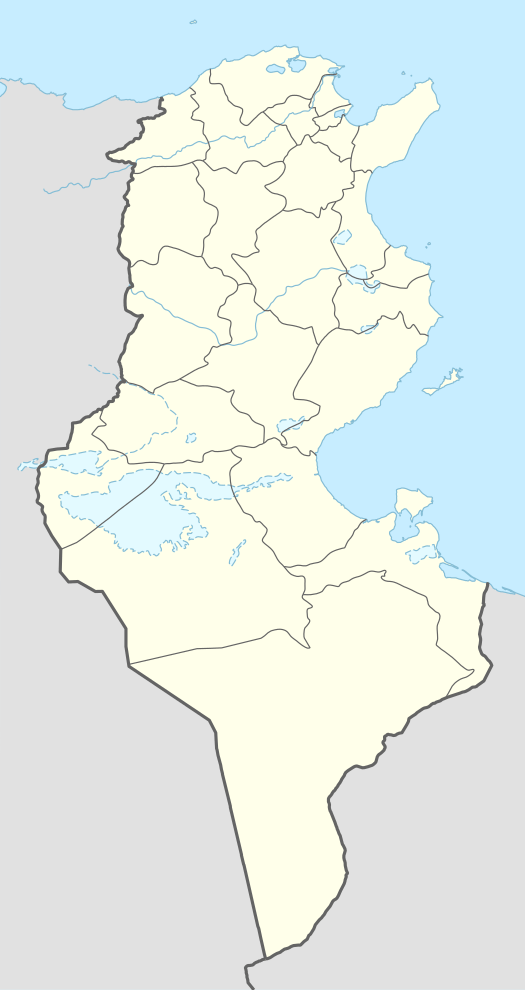List of World Heritage sites in Tunisia
This is a list of World Heritage sites in Tunisia with properties of cultural and natural heritage in Tunisia as inscribed in UNESCO's World Heritage List or as on the country's tentative list. As of 2017, eight sites in Tunisia are included.[1] In addition to its inscribed sites, Tunisia also lists thirteen properties on its tentative list.[2]
World Heritage sites
The table is sortable by column by clicking on the ![]()
- Site; named after the World Heritage Committee's official designation[3]
- Location; at city, regional, or provincial level and geocoordinates
- Criteria; as defined by the World Heritage Committee[4]
- Area; in hectares and acres. If available, the size of the buffer zone has been noted as well. The lack of value implies that no data has been published by UNESCO
- Year; during which the site was inscribed to the World Heritage List
- Description; brief information about the site, including reasons for qualifying as an endangered site, if applicable
| Site | Image | Location | Criteria | Area ha (acre) |
Year | Description |
|---|---|---|---|---|---|---|
| Archaeological Site of Carthage | 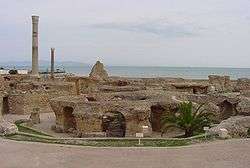 |
Tunis Governorate 36°51′10″N 10°19′24″E / 36.85278°N 10.32333°E |
Cultural: (ii)(iii)(vi) |
616 (1,520) | 1979 | Founded in the 9th century BCE, Carthage developed into a trading empire spanning the Mediterranean. The city was destroyed in 146 BCE in the Punic Wars at the hands of the Romans, but was later reestablished.[5] |
| Dougga / Thugga | 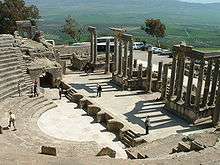 |
Béja Governorate 36°25′25″N 9°13′13″E / 36.42361°N 9.22028°E |
Cultural: (ii)(iii) |
70 (170) | 1997 | The site features the ruins of Dougga, a former capital of a Libyan–Punic state, which flourished under the Romans and the Byzantines, but went into decline in the Islamic period.[6] |
| Amphitheatre of El Jem | 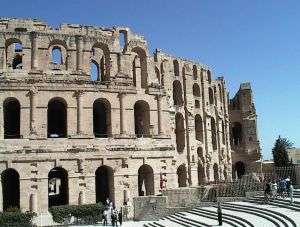 |
Mahdia Governorate 35°17′47″N 10°42′25″E / 35.29639°N 10.70694°E |
Cultural: (iv)(vi) |
1.37 (3.4) | 1979 | Built during the 3rd century, the Amphitheatre of El Jem is North Africa's largest amphitheatre, and the largest one built outside of Italy, with a capacity of 35,000 spectators, regarded as among the most accomplished examples of Roman architecture of its kind.[7] |
| Ichkeul National Park | 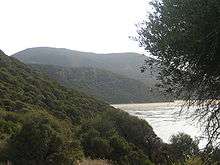 |
Bizerte Governorate 37°09′49″N 9°40′29″E / 37.16361°N 9.67472°E |
Natural: (x) |
12,600 (31,000) | 1980 | Ichkeul Lake and the surrounding wetlands is a destination for hundreds of thousands of migrating birds, including ducks, geese, storks and pink flamingos. It was once part of a chain that extended across North Africa.[8] |
| Kairouan | 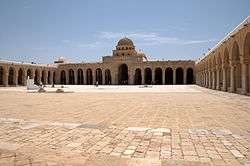 |
Kairouan Governorate 35°40′54″N 10°06′14″E / 35.68167°N 10.10389°E |
Cultural: (i)(ii)(iii)(v)(vi) |
68 (170) | 1988 | Founded in 670, Kairouan was the former capital of Ifriqiya and flourished in the 9th century. Its heritage includes the Mosque of Uqba and the Mosque of the Three Gates.[9] |
| Medina of Sousse | Sousse Governorate 35°49′40″N 10°38′19″E / 35.82778°N 10.63861°E |
Cultural: (iii)(iv)(v) |
32 (79) | 1988 | A prime example of a town from the early Islamic period, Sousse was an important commercial and military port during the 9th century.[10] | |
| Medina of Tunis | Tunis Governorate 36°49′00″N 10°10′00″E / 36.81667°N 10.16667°E |
Cultural: (ii)(iii)(v) |
296 (730) | 1979 | The Medina of Tunis contains some 700 monuments, including palaces, mosques, mausoleums, madrasah and fourtains, testifying to Tunis' golden age from the 12th to the 16th century.[11] | |
| Punic Town of Kerkuane and its Necropolis | Nabeul Governorate 36°56′47″N 11°05′57″E / 36.94639°N 11.09917°E |
Cultural: (iii) |
— | 1985 | Abandoned in 250 BCE during the First Punic War and never rebuilt, Kerkuane is the only surviving example of a Phoenicio–Punic settlement.[12] | |
Tentative list
In addition to sites inscribed on the World Heritage list, member states can maintain a list of tentative sites that they may consider for nomination. Nominations for the World Heritage list are only accepted if the site was previously listed on the tentative list.[13] As of 2017, Tunisia lists thirteen properties on its tentative list:[2]
| Site | Image | Location | Criteria | Year |
|---|---|---|---|---|
| Parc National d'El Feija (El Feidja National Park) |
 |
Jendouba Governorate | Natural: (vii)(viii)(x) |
2008 |
| Parc National de Bouhedma (Bou-Hedma National Park) |
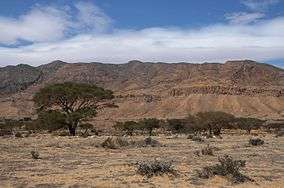 |
Sidi Bouzid Governorate | Natural: (vii)(viii)(x) |
2008 |
| Chott El Jerid | 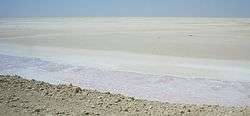 |
Kebili Governorate | Natural: (vii)(viii)(ix)(x) |
2008 |
| Oasis de Gabès (Oasis of Gabès) |
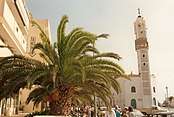 |
Gabès Governorate | Mixed: (iv)(vii)(x) |
2008 |
| Les Mausolées Royaux de Numidie, de la Maurétanie et les monuments funéraires pré-islamiques (Royal Mausoleum of Numidia, Mauretania and Pre-Islamic Funerary Monuments) |
 |
Béja Governorate | Cultural: (ii)(iii)(iv) |
2012 |
| Le complexe hydraulique romain de Zaghouan-Carthage (Roman Hydraulic Complex of Zaghouan-Carthage) |
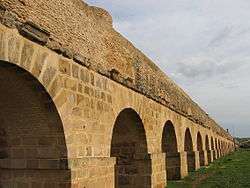 |
Zaghouan Governorate | Cultural: (i)(iv) |
2012 |
| île de Djerba (Island of Djerba) |
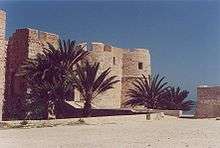 |
Medenine Governorate | Cultural: (v)(vi) |
2012 |
| Les carrières antiques de marbre numidique de Chimtou (Ancient Quarries of Numidian Marbles in Chemtou) |
 |
Jendouba Governorate | Cultural: (ii)(iv) |
2012 |
| Frontières de l’Empire romain: Limes du Sud tunisien (Frontier of the Roman Empire: South Tunisian Limes) |
%2C_Tunisia.jpg) |
Al Mahrah Governorate | Cultural: (ii)(iii)(iv) |
2012 |
| Médina de Sfax (Medina of Sfax) |
 |
Sfax Governorate | Cultural: (ii)(iv)(v) |
2012 |
| Le Permien marin de Jebel Tebaga (Permian Marine of Jebel Tebaga) |
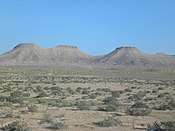 |
Médenine Governorate | Natural: (vii)(viii) |
2016 |
| Le Stratotype de la limite Crétacé-Tertiaire (limite K-T) (Stratotype of the Cretaceous–Tertiary (K-T) Boundary) |
Kef Governorate | Cultural: (vii)(viii) |
2016 | |
| La Table de Jugurtha à Kalaat-Senen (Jugurtha Tableland in Kalaat es Senam) |
Kef Governorate | Mixed: (ii)(iii)(v)(vi)(vii)(viii) |
2017 |
See also
References
- ↑ "tunis". UNESCO. Retrieved 20 July 2017.
- 1 2 "Tentative List – Tunisia". UNESCO. Retrieved 2 August 2018.
- ↑ "World Heritage List". UNESCO. Retrieved 28 May 2010.
- ↑ "The Criteria for Selection". UNESCO. Retrieved 10 September 2011.
- ↑ "Archaeological Site of Carthage". UNESCO. Retrieved 17 August 2011.
- ↑ "Dougga / Thugga". UNESCO. Retrieved 17 August 2011.
- ↑ "Amphitheatre of El Jem". UNESCO. Retrieved 17 August 2011.
- ↑ "Ichkeul National Park". UNESCO. Retrieved 17 August 2011.
- ↑ "Kairouan". UNESCO. Retrieved 17 August 2011.
- ↑ "Medina of Sousse". UNESCO. Retrieved 17 August 2011.
- ↑ "Medina of Tunis". UNESCO. Retrieved 17 August 2011.
- ↑ "Punic Town of Kerkuane and its Necropolis". UNESCO. Retrieved 17 August 2011.
- ↑ "Tentative Lists". UNESCO. Retrieved 7 October 2010.
